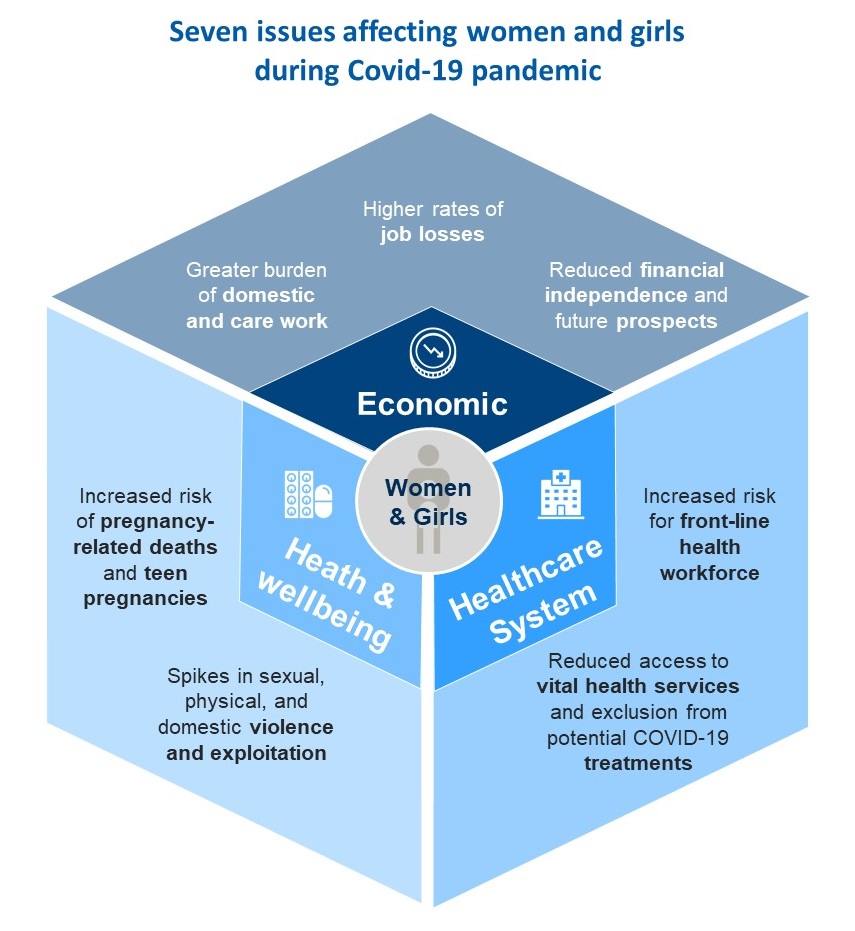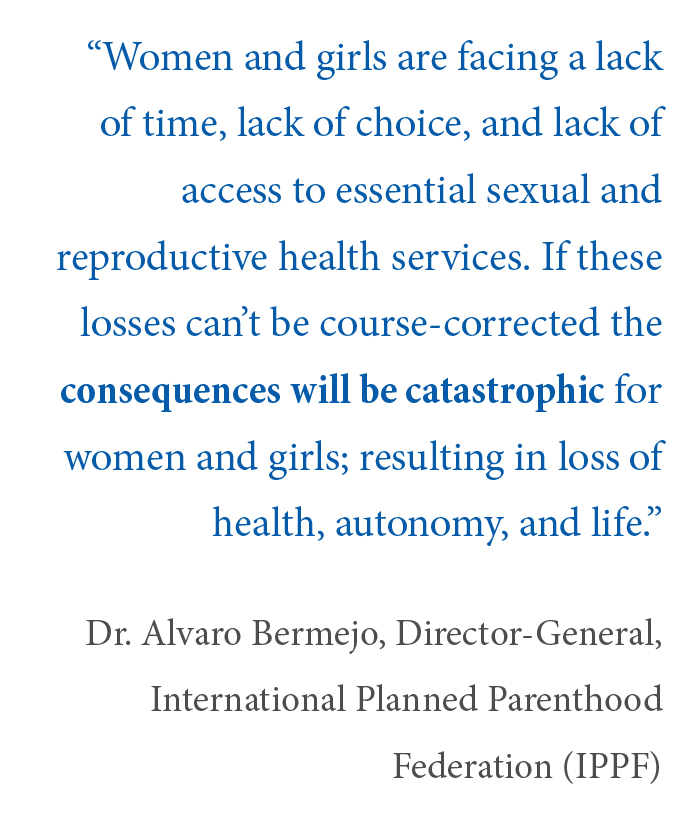
Photo by engin akyurt on Unsplash
Despite its wide geographic spread, the COVID-19 pandemic has not affected everyone in the same way. The attempts of key decision-makers to limit the damage of COVID-19 involve each one of us, but the impacts of these choices are neither equally shared nor highly visible. As we have seen with the Ebola crisis in West Africa and other pandemics, attempts by key decision-makers to curtail the negative impacts of COVID-19 on public health and the economy, in fact, generate a multitude of unintended negative consequences for women and girls, and in most instances further exacerbate existing gender inequalities.
The challenges women face are complex and interrelated. For instance, a woman’s financial independence may be hindered by unequally distributed domestic burdens and low decision-making power at home. The lack of women in leadership positions can result in policies that perpetuate existing gender norms and inequities across entire nations. Listing these issues as isolated events does not do justice to the interconnectedness between them. However, being aware of the range of challenges that disproportionately affect women has helped our clients and partners think about their responses in a more gender-sensitive way (see graphic). 
Download a PDF of these issues with supporting data points >
The severity and prevalence of all of these issues differ between and within countries. These issues also intersect with age, sexual orientation, economic class, race, religion, and physical abilities. Yet one thing is clear: the negative effects are disproportionate for women everywhere.
So what can you do to minimize gender inequities exacerbated by the pandemic?
Both men and women can mitigate the disproportionate impact of these inequities. In this blog, we lay out three categories for how you can think about your pandemic response: in your home, in your organization, and in your initiative and program design.
In Your Home
- Ensure that men and boys share domestic and care work equally with women and girls: Create time to discuss with everyone in your household what needs to be done and how to divide this work. Creative tactics to facilitate these conversations can include games, such as Fair Play. Beyond conversations at the household level, you can have discussions with your employers about how you can flex your capacity to share the domestic and care load with others in your home. Examples include modified schedules, reduced hours, and adjusted expectations and workflow.
- Explore how to compensate those doing domestic work and care: Women lead a large proportion of the informal and formal care economy. If you have the means, consider how you can provide financial support to those who usually help you, such as caregivers and cleaners. In India, for example, the Prime Minister urged citizens in a televised speech to continue to pay support staff during the nation-wide lockdown.
In Your Organization
- Include (and demand) female voices in decision-making: If women are not already represented in key decision-making positions, bring them in now. Organizations with greater gender balance have been found to outperform male-dominated ones by almost 2% on average each year in non-crisis settings. Balance in perspectives and experiences is even more vital in times of crisis. From global health to economic decision-making, being intentional about having women in leadership positions is critical to designing more equitable solutions. Efforts like Operation 50/50’s crowdsourced list of women health security experts can provide ways to boost female representation in decision-making.
- Adopt gender-inclusive workplace practices, measure their impact, and celebrate their success: The pandemic offers an opportunity for employers across sectors to support the shift to more equitable practices among male and female employees. Offer flexible working solutions for all and offer shifts at sociable hours for women to reduce their risks of travelling alone. For employees with young children or elderly who need care, sensitize managers to explicitly recognize the burden of care on both male and female colleagues. Do not assume that men will continue to work at 100% capacity—doing so will only exacerbate gender inequities at the household level. Make sure to measure and track adjustments to inform which work practices you should retain after the pandemic. For example, research has found that companies that do not offer flexible working underperform over a five-year period. Could flexible working provide a way forward for your organization? It is important to also ensure that performance management does not favor those without additional care responsibilities during the pandemic. Instead, celebrate and reward shared care—recognizing your employees’ efforts can demonstrate your commitment to their wellbeing and normalize a more equitable division of household labor.

- Be proactive in offering support and assistance: As you think about your organization’s internal pandemic response, ensure that leadership and management explicitly consider gender differences when examining the risks of confinement and the stress placed on teams. Nonprofits and companies can consider a financial support model for lower-wage staff, many of whom are typically women. Magazine Luiza, a Brazilian retail firm, has offered financial assistance to lower-income employees, including a day-care allowance for nearly 5,500 women employees in stores and distribution centers. Make sure that support systems are in place for accessing comprehensive health care (including for reproductive health) and domestic and sexual violence support. This can include circulating contact numbers for helplines and support services, as well as providing additional support to individuals. Vodafone, a global mobile telephony operator, became the first company to offer up to 10 days of paid leave to employees affected by domestic abuse on a global scale in 2019, and has ramped-up its provision during the COVID-19 lockdown.
In Your Initiative Design
- Re-visit your problem definition with a gender lens: As you identify how gender shows up in your work, consider how to expand your problem definition to reflect differences for men and women. In doing so, articulate new levers you need to build into your program design for equitable impact. In Nigeria, Education as a Vaccine, a nonprofit that focuses on child and youth development, is responding to increased gender-based violence during this pandemic by leveraging its technology platform, My Question and Answer, to provide timely information, counseling, and support to more than 7,000 young Nigerians.
- Collect and analyze data from women and men: Disaggregate your data by gender. If you do not already, start collecting data for men and women separately. Expand your information-gathering methods to capture the female voice (e.g., community engagement to build trust) along with female-specific metrics, particularly related to the issues that disproportionately affect women during COVID-19 (see PDF). Use these metrics to understand the problem and to inform your learning on what works. For instance, a London-based foundation has shared this issues list with its internal Intelligence Gathering team for integration, and the Centre for Global Development has launched a survey on the risks that school closures pose for girls.
- Work together to stopgap the resource deficit for vital services: Already limited resources are further stretched or simply redirected during COVID-19. Seek to partner and cooperate with other organizations that are providing vital services. Merck for Mothers, a global initiative run by pharmaceutical giant Merck, has committed $3 million to help the health systems it partners with to better meet the needs of pregnant women in countries affected by COVID-19. Funders also have an important role in ensuring resources continue to reach women. For instance, Global Fund for Women has committed to funder flexibility in line with its feminist values. In the US, the New York Women’s Foundation recently launched a $1 million response fund, to help women most impacted by COVID-19. Finally, in your interactions with your peers, share how gender is shaping your response and encourage them to incorporate new ways of thinking into their own actions.
Issues that impact women affect our partners, mothers, daughters, sisters, friends, and ourselves—particularly during the COVID-19 pandemic. This crisis offers a platform to raise awareness of these issues, as well as shift our day-to-day attitudes, habits, and ways of working to benefit us all—male and female.
Our ask: commit to one change that you can make at home and in your organization’s COVID-19 response. If an organization like FSG might be able to help, please get in touch:
Learn more about FSG’s Gender Equity work >

